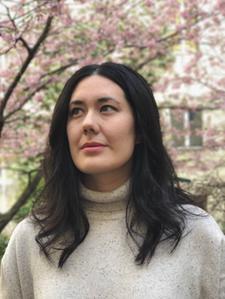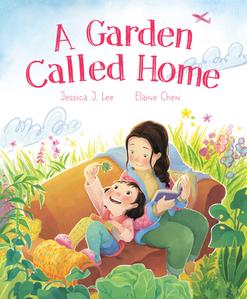
|
|
| Jessica J. Lee (photo: Ricardo A. Rivas) |
|
Jessica J. Lee's diverse background--her mother is Taiwanese, her father Welsh; and both transplanted to Canada, where Lee was born--has provided rich, fertile inspiration for her previous adult nonfiction titles--Turning; Two Trees Make a Forest; Dispersals. Lee makes her children's debut with A Garden Called Home (Tundra, $18.99), illustrated by fellow Canadian Elaine Chen. The vibrant picture book features a girl who travels with her mother to visit faraway family in their warm, verdant home, where she learns valuable, tasty lessons about plants, trees, landscapes, and relationships. When the pair return home where frigid temperatures trap sad Mama inside, the resourceful girl figures out how to coax her mother outdoors to discover the wonders of their local natural world.
After your award-winning titles for adults, what made you write a children's picture book? And was there a specific motivation for creating A Garden Called Home?
I've always wanted to write for children--probably even before I began writing for adults. It wasn't until I'd written my second book, Two Trees Make a Forest, that the idea for A Garden took shape. Two Trees had done really well and the team at Tundra asked if I'd ever tried writing for children, and I basically leapt out of my chair with excitement.
I took as a starting point an idea that I'd touched upon in Two Trees--that pine tree roots help restore integrity to mountainsides after landslides and are often used in regeneration. And I thought: How could this thematically become a story?
How different was writing for children versus writing for older readers?
In some ways, I found the writing process quite similar, while in others it was markedly different. I think this book has "big" themes, the kinds of themes that I'd write into any of my adult books--like intergenerational knowledge and loss, the longing created in migration, a lot of plant and environment knowledge, too. But then the voice is so distinctly different: in my nature writing I am myself; the voice is instinctive.
 For this story, I had to tap into the voice of a child again--I drew a lot on my own childhood to imagine some of this book, but it's fictional, so I had to search for the little girl's voice. I was much more timid in nature than she is! I thought a lot about giving her resilience and thoughtfulness and threw myself into "being" her voice on the page.
For this story, I had to tap into the voice of a child again--I drew a lot on my own childhood to imagine some of this book, but it's fictional, so I had to search for the little girl's voice. I was much more timid in nature than she is! I thought a lot about giving her resilience and thoughtfulness and threw myself into "being" her voice on the page.
As with your earlier books, the natural world infuses Garden. What draws you to continuously write about nature?
I come back to the natural world as a subject partly because of my training in environmental history but mostly for aesthetic reasons. I really want to spend my time with things that move me: natural beauty, of course, but also the high-stakes feeling that we need to document and bear witness to our world under threat. Nature feels magnetic for me. Also, I didn't really start life out in an outdoorsy way--so for me a lot of my writing has been a way of asking, "What might this look like, to really engage with the natural world?"
I realize authors and artists are usually paired by the publisher. What were your interactions like with your illustrator, Elaine Chen? Did you have images in mind before she began her work?
I feel so lucky I got to work with Elaine on this! Tundra was brilliant in that they let me suggest who I wanted to illustrate, and Elaine had worked with a friend of mine, Sennah Yee, on two books [Lin's Lucky Red Envelope; My Day with Gong Gong]. I was so drawn to the joyfulness of her illustrations, so she felt a natural choice. When it came to specific imagery, what amazed me was that, though I'd only left a few very minor notes on illustrations in the manuscript, Elaine's first sketches were basically exactly what was in my brain while I was writing. The first spread, in the living room of the family's home, is literally magicked out of my head. I don't know how she did it! I loved seeing those early sketches become these bouncy, vibrantly colored spreads, and the tiny details: the foods on the table, the neighbors peering over the fence! The endpapers were just a bonus: when I saw that the plants begin as seedlings and "grow" into mature plants at the end, I was completely smitten.
Elaine superbly captures the nurturing mother/daughter relationship in Garden. Have you shared this lovely book with your own mother?
I had some early mock-ups of the book in the winter of 2022, when my mom came to stay with me when my own baby was due. I have this vivid memory of me at 42 weeks pregnant, absolutely giant, sitting with my mom and showing her this story, trying to imagine what it would be like to read it with my own daughter. While the book is fictional, the idea of the mother hating winter is taken from my life--my mom HATES the cold. And she misses Taiwan so much. I think the resonance came across to her, or at least I hope.
Now as a new mother, what are the most important lessons you'd like to impart to your daughter about her co-existence on Earth?
Oh, this is a big question! When I was writing the book, I hesitated a little bit about the mother's sadness, the idea that her daughter would somehow help turn things around. Because that felt like too much pressure to put on a child. But when I realized it was more about finding shared joy, about reaching out into the wider world and forging connections, rather than turning inward, the story clicked. I suppose that's the lesson: look at the world around you--and the people, too--with not just compassion but curiosity. Reach out and make community, whether with those closest to you or those newer. It's a book, really, about connection.
You have two books coming out a month apart, albeit targeting quite different audiences. Your adult title Dispersals is out March 12. What inspired this collection?
I wrote the book--actually both these books--during a really turbulent period. And it was turbulent for everyone, between 2020 and 2022, as we know. The essays began as a column while I was still in Berlin, and then the book idea--writing about plants out of place had been lingering since Two Trees--came together while I was in London. When [the pandemic shutdown] started in 2020, I entered a period of life that was unpredictable, despite my trying to hold tight, to set down roots. The whole book became even more about feeling displaced and unmoored. While my own migration history, and that of my family, was always going to be in the book, I really thought I would be writing it from a stable standpoint, from a single, settled home. I was pregnant and trying to finish it before the baby arrived--but of course I didn't! We had to move again. So, this idea that I'd be writing about all these migrations in the past tense just became impossible. I had to write this book while we were still searching for a home. The last essay, which was originally planned to be a meditation on raising a child in England, doubled in size, became something entirely unplanned--because it had to.
What might you be writing next?
Strangely, I feel like I've come somewhat full circle. There are always lingering questions after a project, and it's just a question of when I'm ready to touch them again. I'm currently writing about freshwaters! After my first book, Turning, I spent time as writer-in-residence at a freshwater ecology lab, so I'm finally getting back to that, thinking about water and biodiversity (and swimming) again. Exactly what the shape of it will be, I'm not yet sure. But I'm puzzling it out. --Terry Hong

